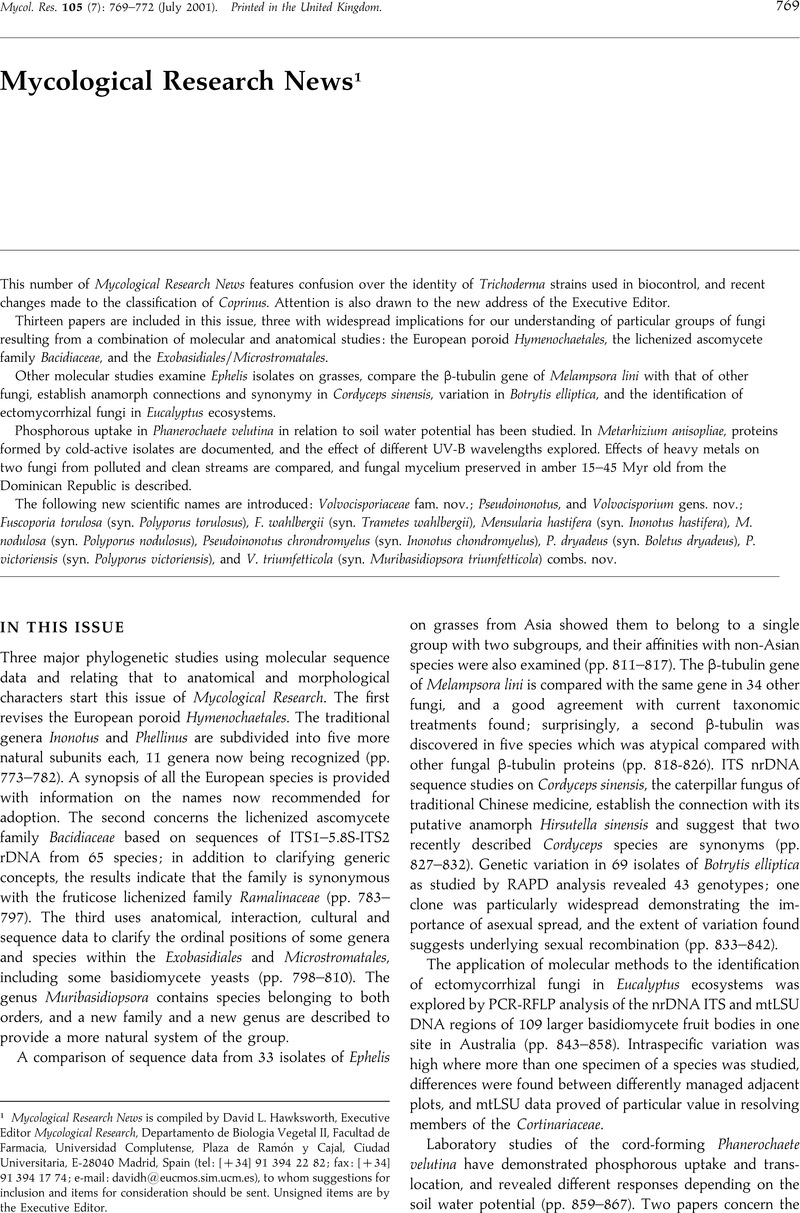Crossref Citations
This article has been cited by the following publications. This list is generated based on data provided by Crossref.
Hjeljord, Linda Gordon
Stensvand, Arne
and
Tronsmo, Arne
2001.
Antagonism of Nutrient-Activated Conidia of Trichoderma harzianum (atroviride) P1 Against Botrytis cinerea.
Phytopathology®,
Vol. 91,
Issue. 12,
p.
1172.
Bara, Maria Teresa F
Lima, Adilson L
and
Ulhoa, Cirano J
2003.
Purification and characterization of an exo-β-1,3-glucanase produced byTrichoderma asperellum.
FEMS Microbiology Letters,
Vol. 219,
Issue. 1,
p.
81.
Hjeljord, Linda Gordon
and
Tronsmo, Arne
2003.
Effect of Germination Initiation on Competitive Capacity of Trichoderma atroviride P1 Conidia.
Phytopathology®,
Vol. 93,
Issue. 12,
p.
1593.
Yedidia, Iris
Shoresh, Michal
Kerem, Zohar
Benhamou, Nicole
Kapulnik, Yoram
and
Chet, Ilan
2003.
Concomitant Induction of Systemic Resistance to
Pseudomonas syringae
pv.
lachrymans
in Cucumber by
Trichoderma asperellum
(T-203) and Accumulation ofPhytoalexins
.
Applied and Environmental Microbiology,
Vol. 69,
Issue. 12,
p.
7343.
Steyaert, Johanna M.
Stewart, Alison
Jaspers, Marlene V.
Carpenter, Margaret
and
Ridgway, Hayley J.
2004.
Co-expression of two genes, a chitinase (chit42) and proteinase (prb1), implicated in mycoparasitism byTrichoderma hamatum.
Mycologia,
Vol. 96,
Issue. 6,
p.
1245.
Lutz, Matthias P.
Wenger, Simone
Maurhofer, Monika
Défago, Geneviève
and
Duffy, Brion
2004.
Signaling between bacterial and fungal biocontrol agents in a strain mixture.
FEMS Microbiology Ecology,
Vol. 48,
Issue. 3,
p.
447.
Shoresh, Michal
Yedidia, Iris
and
Chet, Ilan
2005.
Involvement of Jasmonic Acid/Ethylene Signaling Pathway in the Systemic Resistance Induced in Cucumber by Trichoderma asperellum T203.
Phytopathology®,
Vol. 95,
Issue. 1,
p.
76.
Druzhinina, Irina S.
Kopchinskiy, Alexei G.
Komoń, Monika
Bissett, John
Szakacs, George
and
Kubicek, Christian P.
2005.
An oligonucleotide barcode for species identification in Trichoderma and Hypocrea.
Fungal Genetics and Biology,
Vol. 42,
Issue. 10,
p.
813.
Montero, Manuel
Sanz, Luis
Rey, Manuel
Monte, Enrique
and
Llobell, Antonio
2005.
BGN16.3, a novel acidic β‐1,6‐glucanase from mycoparasitic fungus Trichoderma harzianum CECT 2413.
The FEBS Journal,
Vol. 272,
Issue. 13,
p.
3441.
Druzhinina, Irina
and
Kubicek, Christian P.
2005.
Species concepts and biodiversity in Trichoderma and Hypocrea: from aggregate species to species clusters?.
Journal of Zhejiang University-SCIENCE B,
Vol. 6,
Issue. 2,
p.
100.
Naef, Andreas
Senatore, Mauro
and
Défago, Geneviève
2006.
A microsatellite based method for quantification of fungi in decomposing plant material elucidates the role of Fusarium graminearum DON production in the saprophytic competition with Trichoderma atroviride in maize tissue microcosms.
FEMS Microbiology Ecology,
Vol. 55,
Issue. 2,
p.
211.
Naef, Andreas
Zesiger, Thierry
and
Défago, Geneviève
2006.
Impact of Transgenic Bt Maize Residues on the Mycotoxigenic Plant Pathogen Fusarium graminearum and the Biocontrol Agent Trichoderma atroviride.
Journal of Environmental Quality,
Vol. 35,
Issue. 4,
p.
1001.
Hawksworth, David L.
2006.
Pandora's Mycological Box: Molecular sequences vs. morphology in understanding fungal relationships and biodiversity.
Revista Iberoamericana de Micología,
Vol. 23,
Issue. 3,
p.
127.
Sarrocco, Sabrina
Mikkelsen, Lisbeth
Vergara, Mariarosaria
Jensen, Dan Funck
Lübeck, Mette
and
Vannacci, Giovanni
2006.
Histopathological studies of sclerotia of phytopathogenic fungi parasitized by a GFP transformed Trichoderma virens antagonistic strain.
Mycological Research,
Vol. 110,
Issue. 2,
p.
179.
Samuels, Gary J.
2006.
Trichoderma: Systematics, the Sexual State, and Ecology.
Phytopathology®,
Vol. 96,
Issue. 2,
p.
195.
Jaklitsch, Walter M.
Samuels, Gary J.
Dodd, Sarah L.
Lu, Bing-Sheng
and
Druzhinina, Irina S.
2006.
Hypocrea rufa/Trichoderma viride: a reassessment, and description of five closely related species with and without warted conidia.
Studies in Mycology,
Vol. 56,
Issue. ,
p.
135.
Neuhof, Torsten
Dieckmann, Ralf
Druzhinina, Irina S.
Kubicek, Christian P.
and
von Döhren, Hans
2007.
Intact-cell MALDI-TOF mass spectrometry analysis of peptaibol formation by the genus Trichoderma/Hypocrea: can molecular phylogeny of species predict peptaibol structures?.
Microbiology,
Vol. 153,
Issue. 10,
p.
3417.
Boss, Désirée
Maurhofer, Monika
Schläpfer, Elsbeth
and
Défago, Geneviève
2007.
Elsinochrome A production by the bindweed biocontrol fungus Stagonospora convolvuli LA39 does not pose a risk to the environment or the consumer of treated crops.
FEMS Microbiology Ecology,
Vol. 59,
Issue. 1,
p.
194.
Tondje, P.R.
Roberts, D.P.
Bon, M.C.
Widmer, T.
Samuels, G.J.
Ismaiel, A.
Begoude, A.D.
Tchana, T.
Nyemb-Tshomb, E.
Ndoumbe-Nkeng, M.
Bateman, R.
Fontem, D.
and
Hebbar, K.P.
2007.
Isolation and identification of mycoparasitic isolates of Trichoderma asperellum with potential for suppression of black pod disease of cacao in Cameroon.
Biological Control,
Vol. 43,
Issue. 2,
p.
202.
Sharon, Edna
Chet, Ilan
Viterbo, Ada
Bar-Eyal, Meira
Nagan, Harel
Samuels, Gary J.
and
Spiegel, Yitzhak
2007.
Parasitism of Trichoderma on Meloidogyne javanica and role of the gelatinous matrix.
European Journal of Plant Pathology,
Vol. 118,
Issue. 3,
p.
247.


